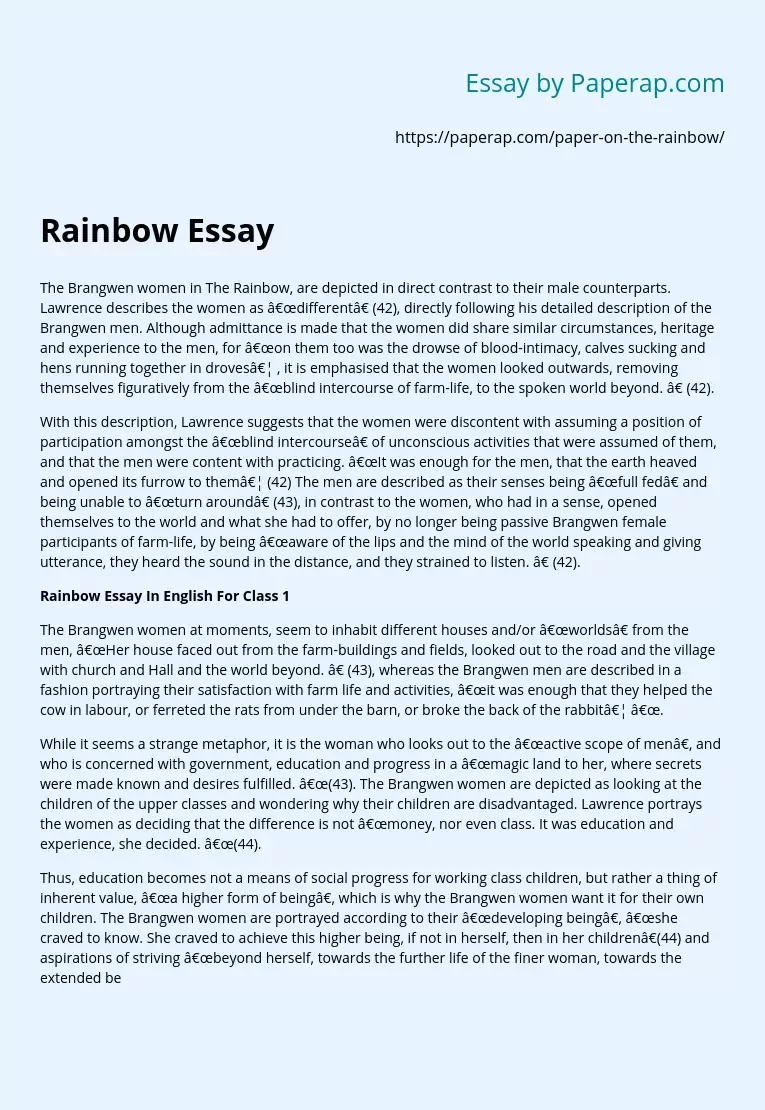The Brangwen women in The Rainbow, are depicted in direct contrast to their male counterparts. Lawrence describes the women as “different” (42), directly following his detailed description of the Brangwen men. Although admittance is made that the women did share similar circumstances, heritage and experience to the men, for “on them too was the drowse of blood-intimacy, calves sucking and hens running together in droves… , it is emphasised that the women looked outwards, removing themselves figuratively from the “blind intercourse of farm-life, to the spoken world beyond.
” (42).
With this description, Lawrence suggests that the women were discontent with assuming a position of participation amongst the “blind intercourse” of unconscious activities that were assumed of them, and that the men were content with practicing. “It was enough for the men, that the earth heaved and opened its furrow to them… (42) The men are described as their senses being “full fed” and being unable to “turn around” (43), in contrast to the women, who had in a sense, opened themselves to the world and what she had to offer, by no longer being passive Brangwen female participants of farm-life, by being “aware of the lips and the mind of the world speaking and giving utterance, they heard the sound in the distance, and they strained to listen.
” (42).
Rainbow Essay In English For Class 1
The Brangwen women at moments, seem to inhabit different houses and/or “worlds” from the men, “Her house faced out from the farm-buildings and fields, looked out to the road and the village with church and Hall and the world beyond.
” (43), whereas the Brangwen men are described in a fashion portraying their satisfaction with farm life and activities, “it was enough that they helped the cow in labour, or ferreted the rats from under the barn, or broke the back of the rabbit… “.
While it seems a strange metaphor, it is the woman who looks out to the “active scope of men”, and who is concerned with government, education and progress in a “magic land to her, where secrets were made known and desires fulfilled. “(43). The Brangwen women are depicted as looking at the children of the upper classes and wondering why their children are disadvantaged. Lawrence portrays the women as deciding that the difference is not “money, nor even class. It was education and experience, she decided. “(44).
Thus, education becomes not a means of social progress for working class children, but rather a thing of inherent value, “a higher form of being”, which is why the Brangwen women want it for their own children. The Brangwen women are portrayed according to their “developing being”, “she craved to know. She craved to achieve this higher being, if not in herself, then in her children”(44) and aspirations of striving “beyond herself, towards the further life of the finer woman, towards the extended being she revealed, as a traveller in his self-contained manner reveals far-off countries present in himself. ” (45).
The Brangwen woman contemplating her child’s potential advance, deciding that it is a “question of knowledge”, as well as the allusion used by her, of the vicar’s power over Tom Brangwen on a desert island, “his soul was master of the other man’s” (44), shares a common trait, in terms of relating these metaphorical descriptions to the essence of what Lawrence wished to achieve: the stages of the advance of consciousness in terms of “knowledge”, suggesting that this stage is both important and temporary; the creative and evolving being unable to be contented with contemplation of what is known, but rather has to discover what is new also. 18).
Thus, ironically, it is the women in The Rainbow who, “whilst her husband looked out to the back at sky and harvest and beast and land, she strained her eyes to see what man had done in fighting outwards to knowledge… her deepest desire hung on the battle that she heard far off, being waged on the edge of the unknown. She also wanted to know, and to be of the fighting host. ” (43), provides for the reader the departure point of Lawrence’s masterfully depicted journey into discovering a history of the relation between man and what lies beyond him, and the history of the struggle of men to become conscious and to become themselves.
Female vs. Male Characters in The Rainbow. (2019, Dec 05). Retrieved from https://paperap.com/paper-on-the-rainbow/

